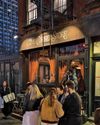
Shortly before 5 p.m. on November 15, Attorney General William P. Barr arrived at the Mayflower Hotel in Washington, D.C., his owlish face wearing a heavy expression. He and his entourage rushed by the lobby bar, where a television was tuned to CNN’s coverage of another day of damning impeachment hearings and raging presidential tweets. Inside a gilded ballroom, hundreds of conservative lawyers—many of them, like Barr, veterans of previous Republican administrations—were gathered to hear him deliver an address to the annual conference of the Federalist Society. “It will come as little surprise to this group,” Barr began, “that I’ve chosen to speak about the Constitution’s approach to executive power.” Even by the standards of this brazen era in Washington, in which all subtext is banished, the theme of the evening was a little on-the-nose—a startlingly explicit case for strengthening Donald Trump’s hold on American government.
“The grammar-school-civics-class version of our Revolution is that it was a rebellion against monarchical tyranny, and that in framing our Constitution, one of the preoccupations, the main preoccupation of the Founders, was to keep the executive weak,” Barr told the audience. “This is misguided.” Instead, Barr advocates for what is known as the “unitary executive theory,” which challenges the long-established doctrine that the president’s control over his branch of government is shared, to some degree, with Congress and the courts. “Whenever I see a court opinion that uses the word share,” Barr said, “I want to run in the other direction.” Critics say that in its maximalist form, the theory is a license for authoritarianism—a concern that Barr dismissed with ridicule.
この記事は New York magazine の December 9-22, 2019 版に掲載されています。
7 日間の Magzter GOLD 無料トライアルを開始して、何千もの厳選されたプレミアム ストーリー、9,000 以上の雑誌や新聞にアクセスしてください。
すでに購読者です ? サインイン
この記事は New York magazine の December 9-22, 2019 版に掲載されています。
7 日間の Magzter GOLD 無料トライアルを開始して、何千もの厳選されたプレミアム ストーリー、9,000 以上の雑誌や新聞にアクセスしてください。
すでに購読者です? サインイン

Trapped in Time
A woman relives the same day in a stunning Danish novel.

Polyphonic City
A SOFT, SHIMMERING beauty permeates the images of Mumbai that open Payal Kapadia's All We Imagine As Light. For all the nighttime bustle on display-the heave of people, the constant activity and chaos-Kapadia shoots with a flair for the illusory.

Lear at the Fountain of Youth
Kenneth Branagh's production is nipped, tucked, and facile.

A Belfast Lad Goes Home
After playing some iconic Americans, Anthony Boyle is a beloved IRA commander in a riveting new series about the Troubles.

The Pluck of the Irish
Artists from the Indiana-size island continue to dominate popular culture. Online, they've gained a rep as the \"good Europeans.\"

Houston's on Houston
The Corner Store is like an upscale chain for downtown scene-chasers.

A Brownstone That's Pink Inside
Artist Vivian Reiss's Murray Hill house of whimsy.

These Jeans Made Me Gay
The Citizens of Humanity Horseshoe pants complete my queer style.

Manic, STONED, Throttle, No Brakes
Less than six months after her Gagosian sölu show, the artist JAMIAN JULIANO-VILLAND lost her gallery and all her money and was preparing for an exhibition with two the biggest living American artists.

WHO EVER THOUGHT THAT BRIGHT PINK MEAT THAT LASTS FOR WEEKS WAS A GOOD IDEA?
Deli Meat Is Rotten